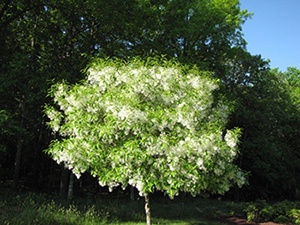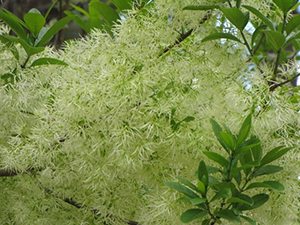Sorry, No Fringe on The Top
Sorry, No Fringe on The Top
By the Site Ecology Team (SET)
May 25, 2016
Virginia, you have every right to claim the rights over Oklahoma to the tree with the fringe on top. Oscar Hammerstein can have his surrey with all its accessories. The American Fringe Tree (Chionanthus virginicus) as the botanical name implies is native to Virginia.

Photo courtesy of Bill Willis.

Photo courtesy of Bill Willis
It can be found from Texas to the east coast and up the coast into New Jersey. Locally it’s called Grancy Graybeard, Old Man’s Beard, Snowflower, Flowering Ash, Grandfathers Graybeard, or White Fringe.
It flowers in late April through mid-May as the leaves are fully expanding. The creamy white finely textured 4-6“ drooping flowers have the appearance of fleecy white fringe.
The fringe tree is dioecious, meaning each plant has either male or female parts. By a nursery/production standpoint it is nearly impossible to propagate by cuttings, so the industry relies on seeds which must undergo cleaning and stratification before they will germinate. Even then, the characteristics of the seedlings can’t be determined until the trees mature. Male and female seedlings look alike, even in flower, but only female plants set fruit. The female plants will produce more fruit if a male plant is nearby. If you buy a plant, you “take’s your chances”. Of the trees along the employee walkway from South Park lot to the Rall Building, there are 10 females and 2 males. Fruit set is usually good.

Photo courtesy of Bill Willis
The tree is a nice ornamental accent as well as a slow grower. In sunny locations with protection from winds, its upright, symmetrical, and rounded, reaching a height of 6-10 feet (20-30’ possible) with a width of up to15 feet. It’s adaptable to various soils type but does better in acidic, well drained but moist conditions. It will tolerate shade but the shape is more open and less symmetrical. If an occasional pruning is necessary, do so after flowering.
The bluish-black fruits that ripen in August and September will attract a variety of birds. In this area, they include American Robins, Eastern Bluebirds, Wood Thrushes, Northern Mockingbirds, Gray Catbirds, Brown Thrashers, Summer and Scarlet Tanagers, and Blue-headed Vireos. Our campus deer have been observed browsing on the fruit and twigs. Caterpillars of the sphinx moths such as Rustic sphinx feed on the foliage.

Photo courtesy of H. Zell
If the trees are stressed, they may fall victim to mites and leaf spot, but usually they are not a serious problem. As we observed this spring, when the emerging leaves are exposed to sudden low temperatures they will be hurt and turn black. It has been reported that the Fringe Trees are susceptible to the Emerald Ash Borer (EAB), so inspect your trees for this pest (consult our flyer or the internet).
In the fall the leaves turn yellow before being shed.
This is definitely a native plant worth considering as an accent in the landscape.



